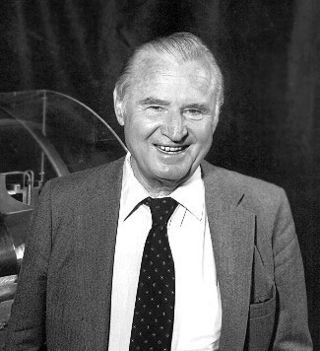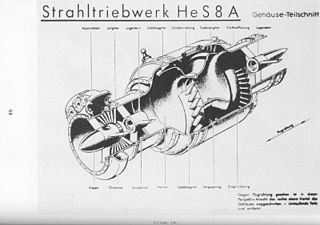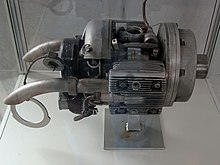
A jet engine is a type of reaction engine, discharging a fast-moving jet of heated gas that generates thrust by jet propulsion. While this broad definition may include rocket, water jet, and hybrid propulsion, the term jet engine typically refers to an internal combustion air-breathing jet engine such as a turbojet, turbofan, ramjet, pulse jet, or scramjet. In general, jet engines are internal combustion engines.

The turbojet is an airbreathing jet engine which is typically used in aircraft. It consists of a gas turbine with a propelling nozzle. The gas turbine has an air inlet which includes inlet guide vanes, a compressor, a combustion chamber, and a turbine. The compressed air from the compressor is heated by burning fuel in the combustion chamber and then allowed to expand through the turbine. The turbine exhaust is then expanded in the propelling nozzle where it is accelerated to high speed to provide thrust. Two engineers, Frank Whittle in the United Kingdom and Hans von Ohain in Germany, developed the concept independently into practical engines during the late 1930s.

Hans Joachim Pabst von Ohain was a German physicist, engineer, and the designer of the first turbojet engine to power an aircraft. Together with Frank Whittle he has been described as the co-inventor of the turbojet engine however, the historical timelines show that von Ohain was still a university student when in January 1930, Whittle filed his first patent for a turbojet engine and Whittle successfully ran his first engine in April 1937, some 6 months before von Ohain. Additionally, prior to designing engine and filing his own patent in 1935, von Ohain had read and critiqued Whittle's patents. Von Ohain stated in his biography, that "My interest in jet propulsion began in the fall of 1933 when I was in my seventh semester at Göttingen University. I didn't know that many people before me had the same thought.". Unlike Whittle von Ohain had the significant advantage of being supported by an aircraft manufacturer, Heinkel who funded his work.

The Junkers Jumo 004 was the world's first production turbojet engine in operational use, and the first successful axial compressor turbojet engine. Some 8,000 units were manufactured by Junkers in Germany late in World War II, powering the Messerschmitt Me 262 fighter and the Arado Ar 234 reconnaissance/bomber, along with prototypes, including the Horten Ho 229. Variants and copies of the engine were produced in Eastern Europe and the USSR for several years following the end of WWII.

The BMW 003 is an early axial turbojet engine produced by BMW AG in Germany during World War II. The 003 and the Junkers Jumo 004 were the only German turbojet engines to reach production during World War II.

Originally called the He 180, the Heinkel He 280 was an early turbojet-powered fighter aircraft designed and produced by the German aircraft manufacturer Heinkel. It was the first jet fighter to fly in the world.

The Messerschmitt Me 328 was a prototype pulsejet-powered fighter aircraft designed and produced by the German aircraft manufacturer Messerschmitt AG.

The Henschel Hs 132 was a World War II dive bomber and interceptor aircraft of the German Luftwaffe that never saw service. The unorthodox design featured a top-mounted BMW 003 jet engine and the pilot in a prone position. The Soviet Army occupied the factory just as the Hs 132 V1 was nearing flight testing, the V2 and V3 being 80% and 75% completed.
This article outlines the important developments in the history of the development of the air-breathing (duct) jet engine. Although the most common type, the gas turbine powered jet engine, was certainly a 20th-century invention, many of the needed advances in theory and technology leading to this invention were made well before this time.
The HeS 30(HeS - Heinkel Strahltriebwerke) was an early jet engine, originally designed by Adolf Müller at Junkers, but eventually built and tested at Heinkel. It was possibly the best of the "Class I" engines, a class that included the more famous BMW 003 and Junkers Jumo 004. As it started somewhat later than these two designs, and was thus expected to enter service later, the Reichluftfahrtministerium (RLM) ordered Heinkel to stop work on the design and put their efforts into more advanced designs.
Helmut Schelp was the director of advanced engine development at the RLM's T-Amt technical division leading up to and during World War II. He used his office to fund a widespread program in jet engine development, which led to many of the engine concepts still used today. In particular, he was instrumental in favoring the use of axial compressors over the simpler but "fatter" centrifugal compressors. Unlike in England where the jet had no single champion within the Air Ministry and their efforts were long delayed as a result, Schelp can be directly credited with the advancement and refinement of the jet in Germany over a few years.

The Heinkel HeS 3 was the world's first operational jet engine to power an aircraft. Designed by Hans von Ohain while working at Heinkel, the engine first flew as the primary power of the Heinkel He 178, piloted by Erich Warsitz on 27 August 1939. Although successful, the engine had too little thrust to be really useful, and work started on the more powerful Heinkel HeS 8 as their first production design.

The Heinkel HeS 8 was an early jet engine designed by Hans von Ohain while working at Heinkel. It was the first jet engine to be financially supported by the RLM, bearing the official name 109-001. Had development continued it would have been known as the Heinkel 001, but it does not appear this was used in practice.
The Avro Canada TR.4 Chinook was Canada's first turbojet engine, designed by Turbo Research and manufactured by A.V. Roe Canada Ltd. Named for the warm Chinook wind that blows in the Rocky Mountains, only three Chinooks were built and none were used operationally. After being scaled up from 2,600 lbf (12 kN) to 6,500 lbf (29 kN), it would become the Orenda.

The Blohm & Voss P 194 was a German design for a mixed-power Stuka or ground-attack aircraft and tactical bomber, during World War II.
The Lyulka TR-1 was a turbojet designed by Arkhip Lyulka and produced by his Lyulka design bureau. It was the first indigenous Soviet jet engine.

The Messerschmitt P.1110 was a design for a single-seat, high-altitude interceptor, prepared for the German Luftwaffe by the Messerschmitt aircraft manufacturing company, under the Emergency Fighter Program during the last months of World War II.
The Junkers Jumo 109-012, known colloquially post-war as Jumo 012, was a turbojet engine under development in Germany during the Second World War. In essence, it was a scaled up version of the Jumo 004. It was intended to power the EF 132 and variants of the Ju 287.

The Messerschmitt Me 262 was a German World War II fighter aircraft built by Messerschmitt in the later stages of the war, and under license by Avia post-war.














